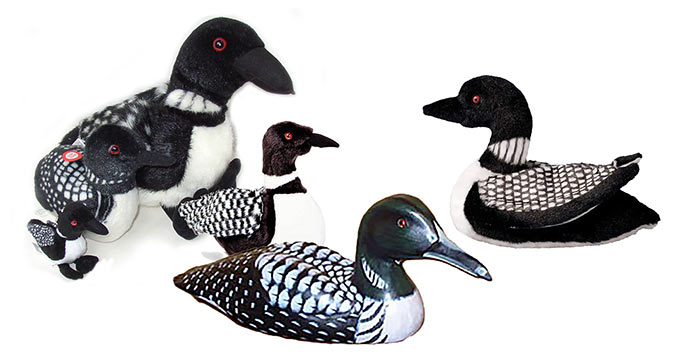


The Common Loon toys and gifts shown above are great for any occasion. We have two Common Loon plush toys from the Stuffed Animal House (one is a keychain), we have the Wild Republic Audubon Bird Loon with sound, Ludwig the Loon from Douglas, a Cabin Critters Common Loon and a Common Loon wood figurine. Find out what is available: at our sponsor's online gift shop.
The Common Loon (Gavia immer) is, as its name
implies, the most common of the loons. Its size ranges from 28 to 36 inches long with a 58 inch wingspan. It has a yodel-like laugh, which is given frequently, near the nest and in flight, especially at night. It is generally silent in winter. In winter the head and neck are darker than the Red-throated Loon. Common loons migrate in small flocks heading to the coast. In flight the head is lower than the body. The wingbeats are fast and uninterrupted by gliding.
Loons are excellent swimmers and divers. Their powerful legs, attached at the rear of the body, give additional leverage to the large webbed feet. Loons spend most of their time in the water and only come ashore to breed and to nest. The Loon can begin its dive by hopping up and forward or it can also quietly submerge from a sitting position. They can dive to 200 feet. Loons eat fish, crustaceans, and some water plants.
Loons like to build their nests near the edge of lakes and rivers. When built among reeds the nest can be large and bulky. Other nests are no more than an indentation filled with plant material. There are two to three dark brownish olive eggs spotted with dark brown. Both parents tend the nest. Incubation takes about 29 days.
The breeding grounds are all the way from Alaska's Aleutian Islands south through Canada to California, Montana and Massachusetts. The Common loon winters along the Great Lakes, the Gulf Coast, and the Pacific and Atlantic coasts. They also breed in Greenland and Iceland.



